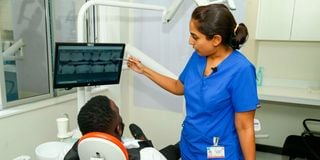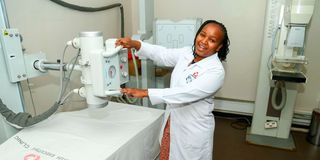I went for a full body wellness check-up. This is what I found out

Dr Fatema Ahmedali performs a dental x-ray on Health and Science reporter Leon Lidigu at Aga Khan Hospital’s Peponi Specialty and Executive clinic in Westlands, Nairobi on March 13, 2023.
What you need to know:
- During our conversation, the family doctor explained that an annual medical check-up is important for everyone, even for patients without any pre-existing medical conditions.
- When detected early through a check-up, there are more treatment options and better outcomes for most diseases.
On Sunday last week, I got a call from Aga Khan University Hospital (AKUH) to remind me of an appointment the following day, a Monday, with their doctors.
I was to undergo a full body wellness check-up that I had been booked for a month ago.
I was to undergo a total of 20 tests. These procedures were going to last for half a day. It was my first ever such elaborate check-up.
I had to clear diary for the day.
To be ready for the checks, Dr Samuel Mucheru had instructed me to fast for eight hours and only hydrate. I was to keep away from some foods, especially red meat.
At 8am the following morning, I arrived at the hospital’s Peponi Specialty and Executive clinic located in Westlands, Nairobi. I was eager and anxious about what was obviously going to be a long and exciting day.
“Like the machines we own such as cars, our bodies too need to be well maintained,” the doctor told me as he took me through the motions of what was going to happen.
For most of the tests, the results would be out immediately, I was told. That made me both excited and apprehensive.
These tests would see me interact with several clinicians at the facility in my most enlightening hospital visit in my adult life.
To start with, a phlebotomy was performed. This is a procedure where a needle pricks the finger and a syringe is used to draw blood from a vein.
Jane Muchemi, a lab technologist, collected blood samples in three vials from my right arm. That was fairly easy. When she handed me a small transparent bottle to pee in, I knew the experience was well underway.
From the blood samples, she explained, the clinic would run a liver function test, a kidney function test and a uric acid test that checks for gout.
Others would be a fasting blood sugars test that checks for diabetes, vitamin D levels test and a thyroid function test that she says helps in body temperature regulation.
Additionally, a full haemogram test for hemoglobin, white blood cell count, platelet count, rhesus factor and a detailed red blood cell index would determine if I had any viral or bacterial infection.
I did the following tests, with some results unexpected and others outright unnerving:
Kidney Function Tests
To check the state of my kidneys, the lab experts performed a test they called serum creatinine. This is simply a blood test that measures the amount of creatinine in blood. The level of serum creatinine goes up when kidneys are not working normally.
The count should be 1.4 for men and 1.2 for women. Normal levels depend on sex, age and the amount of muscle one’s body has.
The second blood test was a Glomerular filtration rate (GFR). This one measures how well your kidneys remove waste, toxins and extra fluid from your blood.
A patient’s serum creatinine level, age and sex are used to calculate their GFR number. According to Centers for Disease Control and Prevention, the lower the GFR, the higher the likelihood the kidneys are not working normally.
Complete blood count
According to the lab expert, a complete blood count (CBC) is a blood test that determines a wide range of conditions, including anemia, infection and leukemia. It measures red and white blood cells, hemoglobin and hematocrit.
A complete blood count measured in cells per litre (cells/L) or grams per decilitre (grams/dL) can show unusual increases or decreases in cell counts. These changes may suggest a medical condition that requires further tests.
Prostate Specific Antigen (PSA) Test
Another test from my blood samples was Prostate Specific Antigen(PSA) Test. PSA is a protein produced by both normal and malignant cells of the prostate gland.
The PSA test measures the level of PSA in the blood and is higher among prostate cancer patients. For men older than 50, a digital rectal exam helps to detect the disease.

Health and Science reporter Leon Lidigu. He did full body medical tests, with some results unexpected and others outright unnerving.
Urinalysis
The doctor explained to me that samples collected from ‘‘morning urine’’ are the best representative for testing. Urine accumulated overnight in the bladder is more concentrated with more accurate information. It is easier to detect traces of substances that may not be present in more diluted samples.
A complete urinalysis has three components. A physical examination that describes the volume, colour, clarity and odour of urine.
A chemical examination identifies pH, red blood cells, white blood cells, proteins, glucose, urobilinogen and other chemicals.
A microscopic examination detects casts, cells, crystals and microorganisms in urine.
Jane explained that a urinary pH greater than 5.5 suggests renal dysfunction related to an inability to excrete hydrogen ions. What I did not know was that men too get checked for yeast infection.
My biggest fear was to be subjected to a stool test that is used to detect colon cancer. As I am below 40, I was relieved to pass this.
HIV and antibody Elisa test
The doctor started by letting me know that this test is optional. The enzyme-linked immunosorbent assay (ELISA) tests a patient’s blood sample for antibodies. Oral fluid (not saliva), collected from the cheeks and gums may also be used to perform an ELISA. A urine sample may also be used for an ELISA test. This one, though, is considered a less accurate method than a blood or oral fluid test.
Although false negative or false positive results are extremely rare, they may occur if the patient has not yet developed antibodies to HIV. Mistakes at the lab may also result in inaccurate findings. Otherwise ELISA tests are usually 99.9 per cent precise.
In case you are wondering, my result came out negative. The doctor would then take me through an extensive session on how to protect myself from HIV and other sexually transmitted infections.
Uric Acid Test
This is a test used to determine whether you have gout or not by measuring the amount of uric acid in urine. Uric acid is a normal waste product produced by the body after breakdown of purines.
Most uric acid dissolves in blood and is filtered by the kidneys before leaving the body in urine. If uric acid builds up in blood, it can form needle-shaped crystals around joints. The condition is called gout.

Caroline Ndegwa,a radiographer, in an X-ray room at Aga Khan Hospital’s Peponi Speciality and Executive clinic on March 13, 2023.
This type of arthritis causes painful swelling in joints. Higher uric acid levels can cause kidney stones or kidney failure.
Fasting Blood Sugar Test
Also known as Glucose Fasting, Jane said this test is done for diabetes mellitus. To have it performed, one has to have been fasting for a number of hours. The test determines your blood-sugar level after an overnight fast.
A fasting blood sugar level of 99 mg/dL or lower is normal. Anything between 100 and 125 mg/dL indicates prediabetes. At 126 mg/dL or higher, you have diabetes.
Vital Signs
The lab technician escorted me to see Betty Murungi, a nurse who is the in-charge of the clinic’s wellness triage. I was here for what Betty called a check of my ‘‘vital signs’’. These include temperature, pulse rate, height, blood pressure and weight. The results would then be used to determine my body mass index (BMI).
Betty informed me that one does not have to be sick to undergo a blood pressure test. She further enlightened me that high blood pressure does not have symptoms. With more young people contracting non-communicable diseases(NCDS), she emphasised the need for this test.
For women, pap smears are done to rule out cancers, which are part of NCDs. Betty noted that women frown upon the procedure due to its intrusive and uncomfortable nature.
Body Mass Index
I am 160 metres tall, which is fairly short. With a weight of about 86 kilogrammes, my BMI came to about 31. Then came bad news. That I am obese.
The Centers for Diseases and Control Prevention classifies obesity into three categories. Class 1: BMI of 30 to, Class 2 BMI of 35 to 40 and Class 3 BMI of 40 and higher.
The recommendation from the doctors was to exercise for 150 minutes weekly. An equivalent of 20 minutes per day. What surprised was the measurement of my waist and hip circumference which came to 99 and 112 centimetres respectively. But why does circumference matter, I wondered.
The doctor explained that certain body shapes are prone to certain health conditions.
Electrocardiogram Test
There was still an electrocardiogram test to go through. This is a common, painless and quick test that detects heart problems such as blocked valves and an enlarged heart. It also monitors the heart’s rhythm.
Doing this test sent a chill down my spine. I was asked to remove my shirt and lay on a bed. A special gel was applied on my chest, wrist and ankle joints. Thereafter different electrodes were placed on my right-hand wrist, chest and ankle joints. After a minute or so, the results were out.
My heart was found to be normal and healthy.
Chest x-ray
My next stop was an x-ray room where Caroline Ndegwa, a radiographer, tested the performance of my lungs. She also tested the state of my lung fluids and examined my heart. The test is done by taking images of the inner cavity of the body with using an x-ray machine through radiation.
To my relief, everything was found to be in perfect condition.
Dental check-up
A routine and voluntary dental x-ray to check a painless but uncomfortable cavity in my pre-molar returned damning results. The dentists described the root canal as ‘‘practically killing the whole tooth.’’ The culprit? Sugary foods, she explained.
What disturbed me even more was the revelation that the cavity had reached the pulp of the tooth, meaning it could get infected.
While booking me for a filling appointment, the dentist recommended that I go for dental cleaning every six months. She also asked me to desist from ‘‘chronic’’ use of any mouthwash, explaining that these are sometimes made with substances that cause the mouth to dry.
Sodium Blood Test
A sodium blood test is used to determine the amount of sodium in your blood. Sodium helps to control the amount of fluid and to balance body pH. It also helps nerves and muscles to work properly.
Apart from a regular check-up, the doctor may order this test if you take medicines likely to alter your fluid balance.
Sodium blood test results that are higher than normal may be a sign of dehydration. Not drinking enough fluids, diarrhoea or certain medicines called diuretics (water pills) may cause this condition.
Sodium blood test results that are lower than normal may be a sign of a loss of sodium from diarrhoea or vomiting. Conversely, some conditions may cause the body to hold onto extra fluid (which dilutes sodium). These include kidney diseases, cirrhosis of the liver, heart failure and certain brain and lung diseases.
This may also be caused by malnutrition, some cancers, taking some medicines such as over-the-counter pain relievers and antidepressants.
Lipid Profile Test
Also known as a lipid panel, this is a blood test used to monitor and screen for any risk of cardiovascular disease. It measures the amount of certain fat molecules called lipids in the blood.
The test measures five different types of lipids from a blood sample. This include total cholesterol, low-density lipoprotein, very low-density lipoprotein, high-density lipoprotein and triglycerides.
Vitamin D 25 Hydroxy
This is the most accurate way to measure how much vitamin D is in your body, according to Jane. Vitamin D helps to control calcium and phosphate levels in the body. A lower-than-normal level of Vitamin D can be due to a deficiency, which often results from poor food absorption, lack of skin exposure to sunlight, darkly pigmented skin, or consistent use of high-SPF sunscreen.
Some medicines, kidney diseases and deficiency of Vitamin D in the diet can also cause this condition. Advanced age may also lead to poor absorption of the vitamin by the body, and so can weight-loss surgery.
Shockingly, my Vitamin D levels were below the expected levels. The advice was that I should spend more time basking in the morning sun. I was also asked to wear sleeveless clothes to expose my skin to morning rays.
Liver Function Tests
The liver is responsible for several functions, including detoxification, synthesis of proteins and production of digestive enzymes. It also helps in metabolism, regulation of red blood cells and synthesis and storage of glucose. This tests determines any damage in the liver.
Thankfully, none were found.
Body Composition Analyser
Still, I had an appointment with a nutritionist and dietician. At Wanjiku Njenga’s clinic, I was put through what the expert called a body composition analyser. The test determines levels of body water, protein minerals and fat.
The test provides a more accurate measure than what a normal weight measure and BMI would do. By simply stepping on the machine, she was able to gather my diet history.
Then came the shocking part: I had gained three kilogrammes in four months. At 27 per cent, the percentage of fat in my body was substantially above the 20 per cent that is recommended for males aged between 18 and 39.
A man with body fat at between 20 and 25 per cent is considered over-fat. Anything above 25 per cent is regarded as obese. Her advice was that I take up physical activities such as indoor aerobic exercises available on YouTube. I do not need to join a gym, she said.
The nutritionist warned me that a higher fat percentage increases inflammation in the body, which increases susceptibility to lifestyle diseases.
My total body water was placed at 52 per cent. Fat around my waist, known as visceral fat, came to 10 per cent which the doctor described as ‘‘okay.’’
The nutritionist had more not-so-flattering news for me: I had to minimise my intake of sugars. Specifically, I had to keep it at two beers at most. Either that or two glasses of wine or two shots of liquor per day. She explained that alcohol contains calories that are metabolised into fat by the liver, storing them in the abdominal area. This is what causes belly fat.
Thyroid Function Tests
A thyroid function test checks how well the small, butterfly-shaped gland in the front of your neck is working. Jane explained that the thyroid is responsible for making hormones that control the way the body utilises energy.
These hormones affect nearly every organ in the body, controlling important functions such as breathing, heart rate, weight, digestion, and moods.
My last stop was back at Dr Mucheru’s office. The lab results were out. The medic did not mince his words. He told me that for my age, a cholesterol level of 4.5 was too high and bad for my health. ‘
‘Normally, it should be below three,’’ he told me to my shock.
Yet another shocker awaited. Instead of the normal 30+, my vitamin D was at 27. Until then, I had not realised my preference for the indoors was putting my health at risk.
During our conversation, the family doctor had explained that an annual medical check-up is important for everyone, even for patients without any pre-existing medical conditions.
According to him, when detected early through a check-up, there are more treatment options and better outcomes for most diseases.
He also disclosed that the majority of Kenyans, however, go to the hospital only when taken ill. His observation was that some urban dwellers occasionally go for check-ups. Women, he said, are more likely to go for check-ups than men.
As I left, my mind was still racing. I had never imagined that at 31, I would have so many underlying conditions. While I was nervous, the experience made me more aware of my health situation.
For the first time, more than ever before, I am deliberate about leading a healthy lifestyle.





